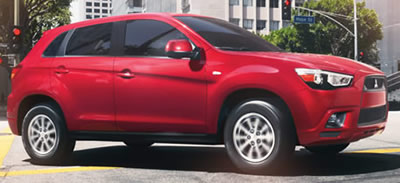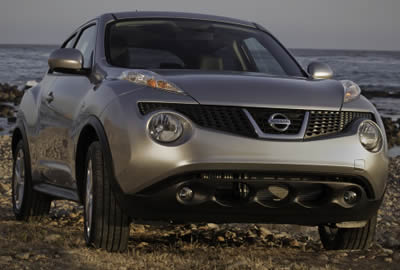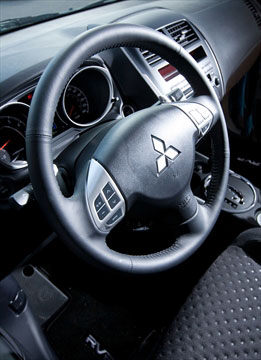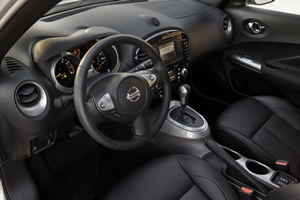|
Mitsubishi RVR, Nissan Juke - A Tale of Two CVT CrossoversBy Jim Bray One has a schnoz like Darth Vader's mask, the other looks like a legless frog on a skateboard, and the makers of both vehicles think they represent compelling solutions to customers' need for a small and capable crossover/wagon. Do they? It depends upon what you're looking for in a vehicle, of course. Mitsubishi's RVR (or "Outlander Sport" in the U.S.) is the tall wagon whose proboscis causes a great disturbance in the force. It's more like a conventional wagon than the Juke – the second vehicle under dissection, er, discussion here. The little Juke is more of a conventional SUV or crossover. Between them, Mitsubishi and Nissan have a lot of bases covered for people seeking a reasonably small utilitarian vehicle. Both vehicles sport – no intimation of sportiness intended – four cylinder engines that get their power to the wheels via continuously variable transmissions. The Mits offers a normally aspirated two liter four cylinder unit that puts out 148 horses – competitive but not earth-shattering – while the Juke's turbocharged 1.6 liter four sends a more healthy 188 horses scrambling madly to the ground, once they get past the turbocharger's initial hesitation. Perhaps not surprisingly, the vehicles feel completely different to drive. The RVR/Outlander Sport and the Juke are available in either FWD or AWD (which Mitsubishi calls AWC, for "All Wheel Control"). Both of my test samples came that way, which was handy considering how the winter of 2010/2011 turned out. The Mits is about seven inches longer than the Nissan, and it doesn't feel quite as nimble – as if Mitsubishi dialed out some of the "sport" quotient in favor of utility, while Nissan ensured the little Juke was a little more playful. It won't keep up to a VW GTI, but that isn't its mandate. I'm not really sure what its mandate is, beyond adding to Nissan's cash on hand (not that there's anything wrong with that!). The company describes prospective Juke buyers as "Distinctive, independent, adaptive and confident," which I take to mean that "Common, dependent, inflexible milquetoasts" need not show up at a Nissan dealership. Not for a Juke, anyway. Mitsubishi simply calls the Outlander Sport/RVR a "four door, five passenger, compact Crossover Utility Vehicle." Said vehicle does its business in an unassuming manner – kind of like a smaller Toyota Venza – and won't get you noticed on the road the way the Juke snagged stares when I steered it around my neck of the woods. That may be in the Mitsubisihi's favor: I was never quite sure if the expressions on the Juke rubberneckers' faces were of interest, curiosity, amusement or astonishment… The RVR/Outlander Sport's CVT was one of the noisiest I've experienced, but the vehicle's also available with a five speed manual transmission that probably makes it a bit more interesting to drive as well. The CVT can pretend to be a six speed manual, and my sample had paddle shifters as well, but the manual doesn't add a lot of fun, just a nice bit of extra control. You can get a six speed manual transmission with the front wheel drive Juke, but when you order the torque vectoring AWD version only the Xtronic CVT is available. That's why my sample had, and it's either quieter than the Mitsubishi's CVT or Nissan has piled on more sound deadening. The Juke features an independent MacPherson strut front suspension with a torsion beam (FWD) or a multi-link (AWD) rear. There are stabilizer bars fore and aft as well. The RVR/Outlander Sport is slung via a MacPherson strut/multilink combination. Both offer good road feel but, as mentioned, the Juke is a bit more fun to toss around – though at a cost of storage space and anonymity. Both all wheel drive systems worked fine on the snowy, slippery roads, letting us drive with confidence regardless of what Person Nature inflicted on us. Both vehicles' four wheel disc brakes with ABS (and related technologies such as Brake Assist) offered very good pedal feel and stopping performance, and neither the ABS nor the traction controls systems were too intrusive.
I preferred the Juke's interior, though the RVR/Outlander Sport feels roomier – especially in the back seat. The driving positions in both vehicles are good, though the RVR's is better because the Juke's steering wheel only tilts. Both vehicles' steering wheels feature redundant controls. The instrument panels are straightforward; ditto for the center stacks, though I found the RVR's displays easier to read. The Nissan has a nifty "I-Conn" feature on its Climate/D-Mode display that's a great space saver: press either the Climate or D-Mode button above the little LCD and the screen – and the labels on the buttons surrounding it – change to display the functions of each mode. I thought it very cool, though judging from the reactions of others to whom I showed it I might be alone. I had a quibble with where Mitsubishi mounted the front seat heater controls. They're on the inside edge of the seats, next to the center console, out of the way and hard to reach. But they work well: I kept two sets of buns toasty warm with them on a couple of particularly nasty days. Both vehicles had sunroofs that I would have had to be some kind of nut to open, and the Mitsubishi has what appears to be a delicious panoramic roof that gives rear seat passengers a chance to watch bird guano (or whatever) come straight at them from on high. Both wagon-like thingies also offer Bluetooth, with the Mits tossing audio streaming into the mix, though it wouldn't let me skip forward through tracks using the car's interface. My sample Nissan had a real iPod connector in the glove compartment. It extends reasonably far and apparently you can run the iPod right from the stereo, which is wonderful. I don't have an iPod but the connector ends in a USB port and there's also an auxiliary port you can use. All it needs is a place to hook up a turntable. My test Juke didn't seem to have quite the build quality of the Mitsubishi, thanks to rattles in the area of the hatch and windshield. And the driver's side windshield wiper leaves almost two inches uncleared on the driver's side. That's too much but, because of the rounded-corner design of the windshield, I doubt there's much else Nissan could have done short of redesigning the windshield. On the other hand, I enjoyed driving the Juke more than the RVR/Outlander Sport, though since the Juke is a turbo, it's harder to drive smoothly because the turbo tends to come on with a whoosh. In other words, step on the gas, wait a sec, and hang on! Give the storage edge to the Mitsubishi, thanks to its more conventional wagon configuration as opposed to the sloping, crouching frog's back of the Juke. And what's with the name Juke? Random House says it means "a fake or feint, usually intended to deceive a defensive player," which I doubt means that Nissan thinks the Juke'd be great for playing chicken. Juke also means "a cheap roadhouse" or "brothel," neither of which is probably what Nissan had in mind, either. Then there's "jukebox," which might be more at home on the boxlike Cube. Oh, dear. I guess I just don't get it. Choosing between these vehicles shouldn't be hard, depending upon what you're looking for. If you want a tall wagon with room to haul stuff, pick the Outlander Sport/RVR. If you want a little more fun behind the wheel (but only a little!) and can stand the sight of the Juke when you enter your driveway or garage, the Nissan's is a pretty cool idea. Copyright 2011 Jim Bray Jim Bray is a member of the Automobile Journalists Association of Canada. His columns are available through the TechnoFile Syndicate.
We welcome your comments! |
|
|||||||||||




